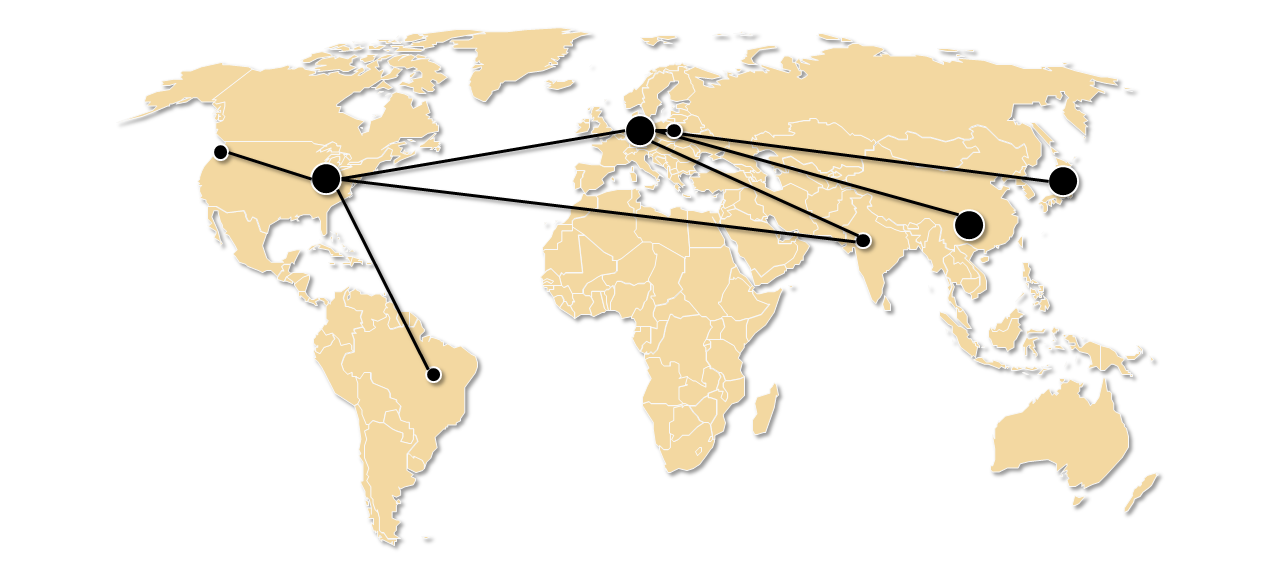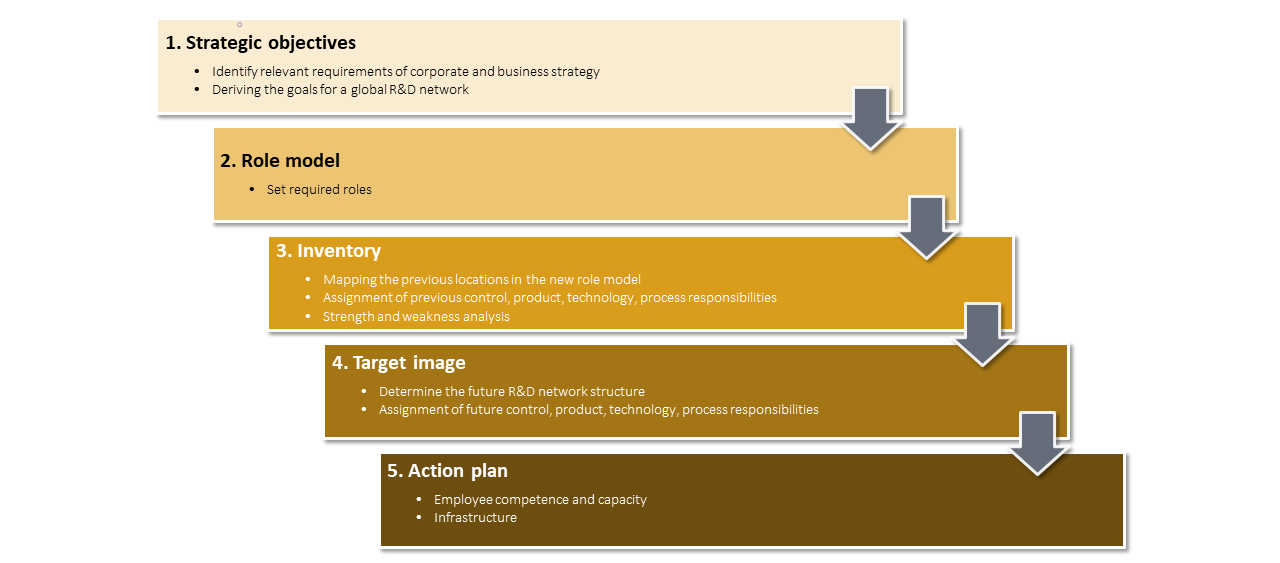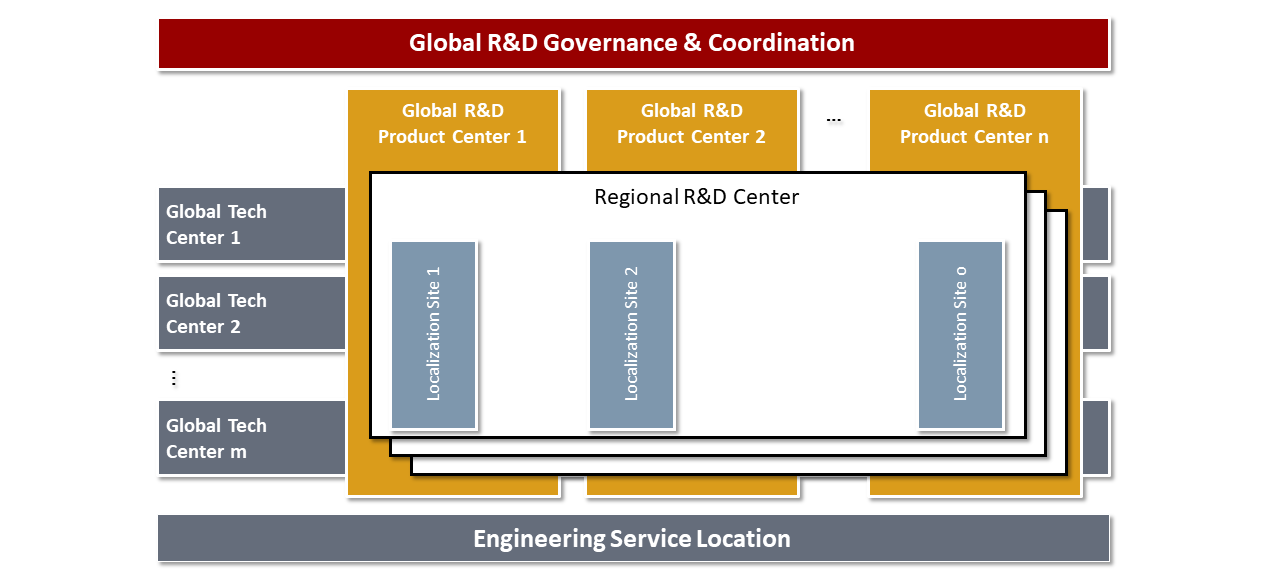Global development network
The adaptation of products to regional requirements, high cost pressure and thin personnel markets associated with the development of global markets present R&D Managers with enormous challenges. At the same time, however, a global set-up also opens up opportunities! Powerful global R&D networks are, therefore, an essential success factor for manufacturers of mechatronic products. We help you to tap into the unused opportunities of globalisation, to gradually transfer existing structures into a systematic, robust global network structure and to anchor improvements with accompanying change management.
In 5 steps to an efficient R&D network structure
All industrial companies today adopt an international approach: On the one hand, they need to be present in the markets where they sell their products. On the other hand, they develop and produce cost-effectively in countries such as Romania or India.
The decisions for the respective location were, of course, made consciously and for good reasons at the time. But over time, the locations have evolved – and often in an uncontrolled way. This network of development sites, which has emerged piece by piece under pressure to act, therefore, often lacks a neatly woven global pattern in the form of a comprehensible logic. Rather, it has grown organically, it lacks organisation, it is opaque and, moreover, often has gaps or overlaps.
In this situation, a structured, strategic approach to solving the problem is the best way to raise the performance of the global R&D network to a new level. To do this, our consultants rely on the following five steps in client projects:
1. Set strategic goals
Your global R&D network must support the goals of your corporate strategy in the best possible way. Therefore, the first task is to derive the requirements for a global R&D structure from the corporate strategy.
For example, if your strategic goal is to be the innovation leader in certain emerging products or technologies, you need access to the best talent and close contact with innovative customers. If, on the other hand, you want to significantly expand your sales as an industrial supplier in China, you need consulting and application centres located there, including competent development engineers.
Global product or process standards are developed centrally. Depending on the availability of competencies for products or technologies, a global segmentation of responsibility across different locations can make sense. Customer-specific product applications, on the other hand, are always carried out where the most important customers are. Such considerations must be taken into account in your R&D strategy and made transparent to all stakeholders.
2. Develop a role model and take stock
In most cases, five to six global roles for your development network can be derived from the R&D goals. You can see what these might be, for example, in our graphic. We help you to develop and precisely describe roles with a view to your strategic requirements and goals.
3. Carry out an ACTUAL analysis and compare it with your goals
To identify potential for improvement, we need to assess your situation in detail. This is often done during a site visit because important factors can only be meaningfully ascertained on the spot. Using the jointly developed role model, our consultants provide a transparent overview of your development locations, their competencies, capacities, strengths and weaknesses. Within the framework of an ACTUAL analysis of the entire network structure, we identify imbalances (e.g. problems in cross-location cooperation, poor resource allocation) and unused potential. You will discover in which areas you need to build up and redistribute competences and capacities or harmonise interfaces.
4. Develop target images
With a view to the findings of the ACTUAL analysis, your strategic goals and your global role model, we identify with you the right, overlap-free defined roles and associated responsibilities for each development location. A location can embody several roles at the same time.
5. Establish development plans and governance model
Together with us, you draw up a development plan for each location. It describes how the respective location should approach its target configuration over time. You close gaps, eliminate overlaps, adjust capacities and standardise your organisational structures. It is best to review and adjust your development plan annually.
Five tips from practice
- Work with a simple and clear role model.
- Define responsibilities without overlaps or gaps.
- Involve site representatives, key suppliers and development partners in the analysis and design processes.
- Balance the distribution of responsibilities globally to avoid a two-class society.
- Link the systematic further development of the R&D network to the strategy process of your company.
We optimise your R&D network
With the help of these five steps, we build new R&D development networks, as well as improve and expand existing structures. In doing so, we rely on our professional expertise, which our consultants have acquired in leading positions in product development and R&D management across all industries, and on our comparative experience from numerous consulting projects.
We attach great importance to structured change management, with which we actively accompany and shape the development process in manufacturing companies. Experience shows that this is the most important basis for improvement: this is because only when managers and employees are convinced and motivated can changes come about that are irreversibly good.
The benefit to you
- You obtain clarity about your strategic requirements and goals.
- You create transparency about your current R&D footprint.
- You improve your cost and competitive position.
- You create a role-based and indicator-supported strategy foundation for the expansion of your network.
- You reduce the fear of globalisation in your company.



